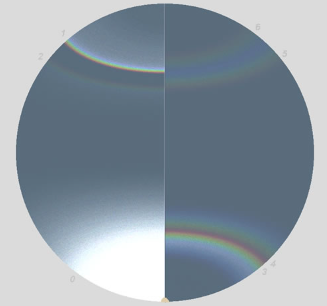Bowsim Rainbow Simulator
Bowsim Rainbow Simulator: Simulating the Beauty of Rainbows
Have you ever wondered how rainbows form and why they appear in different orders? Thanks to advancements in technology, we now have tools like the Bowsim Rainbow Simulator that allow us to explore and understand the intricate physics behind these mesmerizing optical phenomena. In this article, we will delve into the features and capabilities of Bowsim, shedding light on its numerical ray tracing techniques and its ability to simulate rainbows from various types of raindrops.
Exploring the Origins of Bowsim Rainbow Simulator
Bowsim Rainbow Simulator is built upon the foundation of HaloSim, a renowned ice halo simulation program. However, instead of focusing on crystal ray tracing algorithms, Bowsim introduces new algorithms specifically designed for spheres and general ellipsoids. This enhancement enables the simulation of bows from non-spherical raindrops, providing a more comprehensive understanding of the formation process.
Unveiling the Features of Bowsim Rainbow Simulator
-
Numerical Ray Tracing: Bowsim employs numerical ray tracing techniques to accurately simulate classical rainbows. By tracing the paths of individual light rays through raindrops, the simulator recreates the intricate scattering and refraction processes that result in the formation of rainbows.
-
Rainbow Order Filtering: With the help of ray filters, Bowsim allows users to selectively display specific rainbow orders. This feature proves particularly useful when examining half or full-screen views, enabling a focused analysis of different orders of rainbows.
-
Intuitive User Interface: Although not currently available for download, the developers had intended to make Bowsim accessible to a wider audience. However, due to time constraints, they were unable to finalize the user-friendly interface. Despite this setback, Bowsim remains a valuable tool for researchers and enthusiasts interested in delving deeper into the world of atmospheric optics.
A Visual Journey Through Rainbow Orders
The Bowsim Rainbow Simulator provides a captivating visual representation of the first six rainbow orders. In an all-sky projection centered on the zenith, the left half of the image showcases the primary and secondary bows, accompanied by the zero-order glow. Interestingly, the intensity of the left-hand view is only 7.5% of that seen in the right-hand view, which focuses on the third to sixth order bows. To enhance clarity, the right-hand view has been filtered to remove the lower order bows, allowing for a more detailed examination of higher-order rainbows.
The Limitations and Future Prospects
While Bowsim Rainbow Simulator offers valuable insights into the physics of rainbows, it is currently not available for public download. However, despite this limitation, the simulator's capabilities provide researchers with a powerful tool to explore and analyze different aspects of atmospheric optics. In the future, there is hope that Bowsim will be made more accessible through the development of a user-friendly interface, allowing a wider audience to appreciate and study the intricacies of rainbow formation.
Conclusion
The Bowsim Rainbow Simulator stands as a testament to our ongoing quest to understand and appreciate the wonders of nature. Through numerical ray tracing and advanced algorithms, this simulator allows us to unravel the mysteries behind the formation of rainbows. As we continue to explore the complexities of atmospheric optics, tools like Bowsim provide us with a deeper appreciation for the beauty and science that lie within these captivating natural phenomena. Although not currently available for public use, we eagerly anticipate the day when Bowsim will be accessible to all, enabling a greater understanding and admiration for rainbows and their intricate orderings.

BowSim uses numerical ray tracing to simulate the classical rainbows from large raindrops.
It is based on the ice halo simulation program HaloSim. The latter's crystal ray tracing algorithms were replaced by ones for spheres and general ellipsoids, the latter are useful for simulating bows from non-spherical drops.
Ray filters allow half or full screen views where only selected rainbow orders are displayed.
Regettably, BowSim is not available for download. The intention was to do so but I do not have the time to make the interface user friendly.
The first six rainbow orders. The sun on the horizon at the base of this all sky projection centered on the zenith. The left hand half shows the primary and secondary bows and the zero order glow. The left hand intensity is only 7.5% of that of the right hand view showing 3rd to 6th order bows. The right hand was filtered to remove the lower order bows.
Note: this article has been automatically converted from the old site and may not appear as intended. You can find the original article here.
Reference Atmospheric Optics
If you use any of the definitions, information, or data presented on Atmospheric Optics, please copy the link or reference below to properly credit us as the reference source. Thank you!
-
<a href="https://atoptics.co.uk/blog/bowsim-rainbow-simulator/">Bowsim Rainbow Simulator</a>
-
"Bowsim Rainbow Simulator". Atmospheric Optics. Accessed on November 22, 2024. https://atoptics.co.uk/blog/bowsim-rainbow-simulator/.
-
"Bowsim Rainbow Simulator". Atmospheric Optics, https://atoptics.co.uk/blog/bowsim-rainbow-simulator/. Accessed 22 November, 2024
-
Bowsim Rainbow Simulator. Atmospheric Optics. Retrieved from https://atoptics.co.uk/blog/bowsim-rainbow-simulator/.